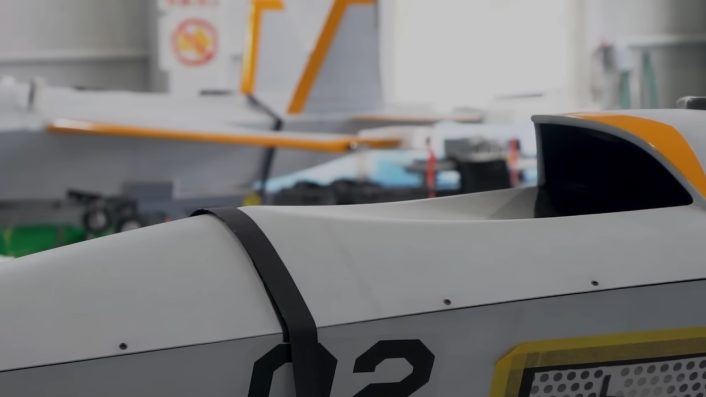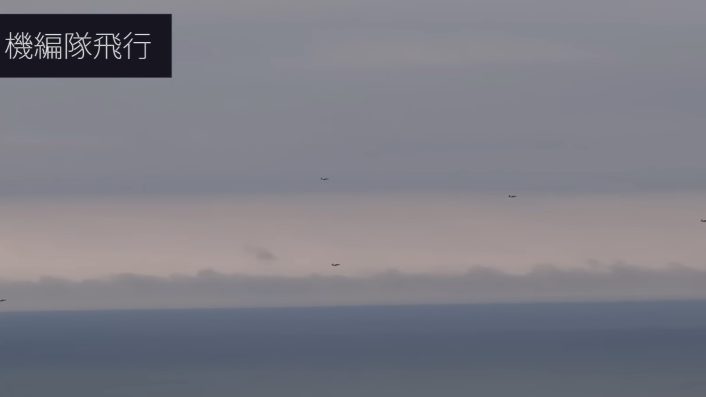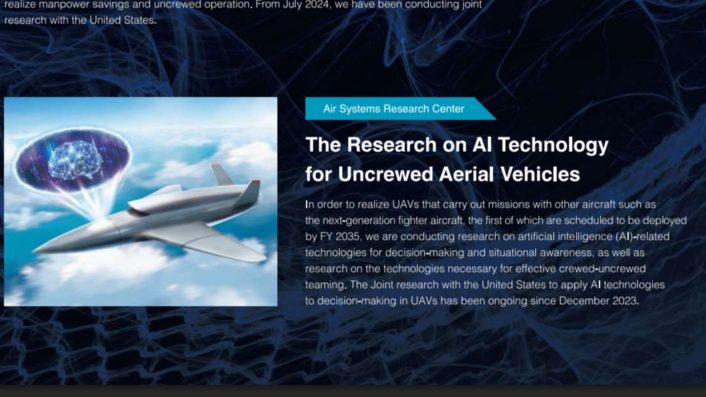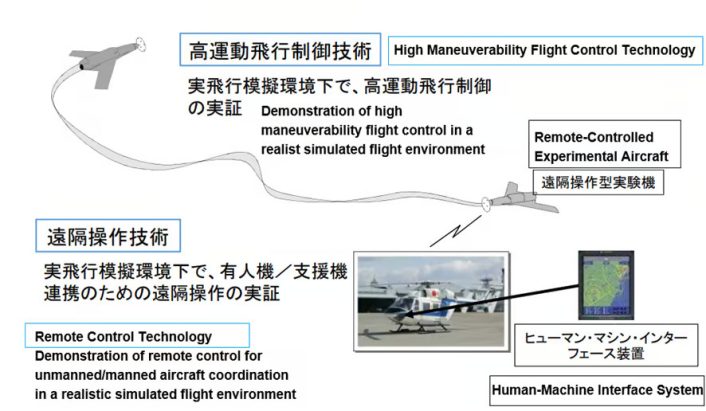The Acquisitions, Technology and Logistics Agency said it tested remote operation of drones using tablets from inside a helicopter and autonomous flight navigation.
The Japan Ministry of Defence’s Acquisitions, Technology and Logistics Agency (ATLA) released on Nov. 21, 2025, a video of a Man-Unmanned Teaming (MUM-T) demonstration with five small jet-powered uncrewed aircraft conducting various coordinated maneuvers. The test campaign took place in October, managed by the agency’s Air Systems Research Center.
The agency worked with five unmanned fixed-wing aircraft it received from its technology partner Subaru Corporation on Jul. 9, a Nov. 20 ATLA statement said. The UAVs were controlled from inside a helicopter using tablets, as part of “research into unmanned aircraft capable of cooperation with manned fighter aircraft.”
Specifically, the research focused on “remotely controlled support aircraft technology” and “ automatic flight path generation technology for unmanned aircraft,” said the agency. This points to autonomous waypoint navigation along map routes set by the human controller on the tablet, and figuring out the logistics, tactics and procedures for pilots for controlling collaborative drones, while also flying the aircraft.
The tablet arrangement is evolving as the first mechanism for operating collaborative unmanned systems from current aircraft. The recent test of an MQ-20 Avenger controlled by the pilot of an F-22 Raptor also involved a tablet-based Pilot Vehicle Interface (PVI).
The drones and the test
The cranked-kite wing UAVs with canted v-tails are inspected inside the AERI’s facility, before being tested in batches. The UAVs have a top-mounted intake, with a long slope leading into the intake.
Two drones take off first and fly in coordinated formation flights over the sea, followed by another flight by all the five drones. The video must be a composite of all the tests that ATLA said took place in October.

We also see the crew installing an unidentified payload on the ventral side of the unmanned aircraft. The nature of the payload is unclear.
A short clip from inside the Bell 205 helicopter, bearing the markings of Japanese automobile and technology major Subaru, shows the pilots wearing these tablets strapped to their thighs. The tablets are displaying what appear to be navigation maps that could pertain to waypoint routes for the drones.

The description in the ATLA video said: “The Aviation Equipment Research Institute is conducting research into unmanned aircraft that can work in conjunction with manned aircraft. As part of research into remotely controlled support aircraft technology, flight tests were conducted using an unmanned experimental aircraft and a manned helicopter to simulate mission maneuvers and five-aircraft formations.” The drones are small-sized, roughly the size of a small hobby RC (Remote Controlled) airplane.
ATLA’s statement further added: “Subsequently, through October 2025, we conducted flight tests simulating mission maneuvers and five-aircraft formations using the unmanned experimental aircraft and a manned helicopter, obtaining data necessary for research, such as the generated flight path and the workload of pilots operating the unmanned experimental aircraft. Going forward, we will analyze the obtained data, verify the effectiveness of the technology, and steadily advance research and development toward the realization of future unmanned aircraft.”

Testing objectives
Such tests generally validate the control software, algorithms and crunch data before expanding the trials. Given that the project was overseen by ATLA, one of the goals may have been to test and validate standard state-validated semi-autonomous/autonomous control software and interface for military drones.
We have seen the emphasis on “Government Reference Architecture” and independent “Autonomy Stacks” for projects like the Scaled Composites Model 437 and GA-ASI’s MQ-20 Avenger. These projects too are being pursued to perfect autonomous flight and combat technologies for future CCAs.
An ATLA document from earlier this year, listing the R&D initiatives in defense being undertaken by the government, mentions “Research on AI Technology for Uncrewed Aerial Vehicles” among the current projects.

The short description says: “In order to realize that UAVs can carry out missions with other aircraft such as the next-generation fighter aircraft, the first of which are scheduled to to be deployed by FY 2035, we are conducting research on artificial intelligence (AI)-related technologies for decision-making and situational awareness, as well as research on technologies necessary for effective crewed-uncrewed teaming. The Joint research with the United States to apply AI-technologies to decision-making in UAVs has been ongoing since December 2023.”
The document also has concept renditions of other weapons like the Electromagnetic Railgun, DEWs (Directed Energy Weapons) such as High-Powered Microwave, High Energy Lasers and the GCAP (Global Combat Air Program with the UK and Italy).

Agreement with U.S. and Japan MoD plans
The aforementioned joint research with the U.S. pertains to an MoU with the Department of Defense’s Defense Innovation Unit that ATLA announced on Sep. 9, 2025. Aimed at “Defense Innovation Cooperation,” the efforts will hold competitions and promote start-ups for the “integration of cutting edge commercial technologies into defense systems more rapidly and efficiently, and strengthening of defense production and technological base.”
Interestingly, Asian Military Review published on Aug. 21 a report by NSBT Japan which included an image from a fiscal 2018 Japan MoD document detailing future defense R&D projects to be overseen by ATLA.

The report showed an illustration of tests of “High Maneuverability Flight Control Technology” with “Remote-Controlled Experimental Aircraft” testing “remote operations for MUM aircraft coordination” and human machine interface. It also included a picture of a helicopter and the tablet.









